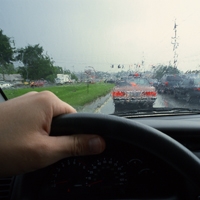
Either you like roundabouts—circular intersections, generally with four exit points—or you don’t. There seems to be no middle ground when it comes to them. Those who like roundabouts say they’re easy, safe and keep traffic moving. Those who don’t like them say roundabouts are confusing and make you veer right in order to turn left.
A modern roundabout is simply defined as a one-way circular intersection. There are three basic principles to a roundabout:
1. Vehicles approaching the intersection must yield before entering.
2. Vehicles entering the roundabout are guided to the right to avoid a center island.
3. The size of the center circle and the angle of the entry into the intersection can be designed to slow vehicle speeds.
The popularity and interest in roundabouts has increased dramatically with highway and transportation departments across the nation. Many states have implemented policies that require roundabouts to be included in all intersection analyses where signals or four-way stops are considered.
The primary objective of any intersection is to move the greatest amount of traffic in the safest manner possible. When designed correctly, the modern roundabout is the safest, most efficient form of intersection for vehicles, bicycles and pedestrians. Roundabouts provide 75 percent less conflict points of intersecting vehicles than a traditional intersection.
Many neighborhoods welcome roundabouts because they control and maintain lower speeds for entering and circulating vehicles. Vehicles are slowed as they approach the intersection by the use of splitter islands, signs and pavement markings. Some roundabouts have landscaping or signs in the center island for aesthetics, which has a tendency to get drivers to slow down.
Slower speeds mean shorter breaking distances and more decision- making time. Accident rates have been shown to decrease dramatically in frequency and severity in roundabouts as compared to traditional signalized or four-way stop intersections.
Roundabouts can handle a high volume of traffic. Because of the principles of roundabout design, vehicles can enter from each leg of the intersection simultaneously. When the volume of traffic is relatively balanced on each leg of the intersection, vehicle delays are low. Slower vehicle speeds provide the motorist an opportunity to enter the circulating roadway in small gaps. This keeps traffic moving and provides high efficiency.
Generally, roundabouts are less expensive in the long run than signalized intersections. Initial construction of roundabouts may be more expensive but there’s virtually no maintenance or operating costs thereafter.
Roundabouts may not be ideal in every situation. They don’t work well where traffic volumes are high and one leg of the intersection has significantly more vehicles than the other leg. In some cases, the expense of purchasing property to construct a roundabout in a highly developed area may outweigh the benefits of capacity or traffic calming.
Like them or not, it appears that the modern roundabout is here to stay. Our best choice may be to understand how to drive through them and enjoy the center island aesthetics. IBI
A modern roundabout is simply defined as a one-way circular intersection. There are three basic principles to a roundabout:
1. Vehicles approaching the intersection must yield before entering.
2. Vehicles entering the roundabout are guided to the right to avoid a center island.
3. The size of the center circle and the angle of the entry into the intersection can be designed to slow vehicle speeds.
The popularity and interest in roundabouts has increased dramatically with highway and transportation departments across the nation. Many states have implemented policies that require roundabouts to be included in all intersection analyses where signals or four-way stops are considered.
The primary objective of any intersection is to move the greatest amount of traffic in the safest manner possible. When designed correctly, the modern roundabout is the safest, most efficient form of intersection for vehicles, bicycles and pedestrians. Roundabouts provide 75 percent less conflict points of intersecting vehicles than a traditional intersection.
Many neighborhoods welcome roundabouts because they control and maintain lower speeds for entering and circulating vehicles. Vehicles are slowed as they approach the intersection by the use of splitter islands, signs and pavement markings. Some roundabouts have landscaping or signs in the center island for aesthetics, which has a tendency to get drivers to slow down.
Slower speeds mean shorter breaking distances and more decision- making time. Accident rates have been shown to decrease dramatically in frequency and severity in roundabouts as compared to traditional signalized or four-way stop intersections.
Roundabouts can handle a high volume of traffic. Because of the principles of roundabout design, vehicles can enter from each leg of the intersection simultaneously. When the volume of traffic is relatively balanced on each leg of the intersection, vehicle delays are low. Slower vehicle speeds provide the motorist an opportunity to enter the circulating roadway in small gaps. This keeps traffic moving and provides high efficiency.
Generally, roundabouts are less expensive in the long run than signalized intersections. Initial construction of roundabouts may be more expensive but there’s virtually no maintenance or operating costs thereafter.
Roundabouts may not be ideal in every situation. They don’t work well where traffic volumes are high and one leg of the intersection has significantly more vehicles than the other leg. In some cases, the expense of purchasing property to construct a roundabout in a highly developed area may outweigh the benefits of capacity or traffic calming.
Like them or not, it appears that the modern roundabout is here to stay. Our best choice may be to understand how to drive through them and enjoy the center island aesthetics. IBI

